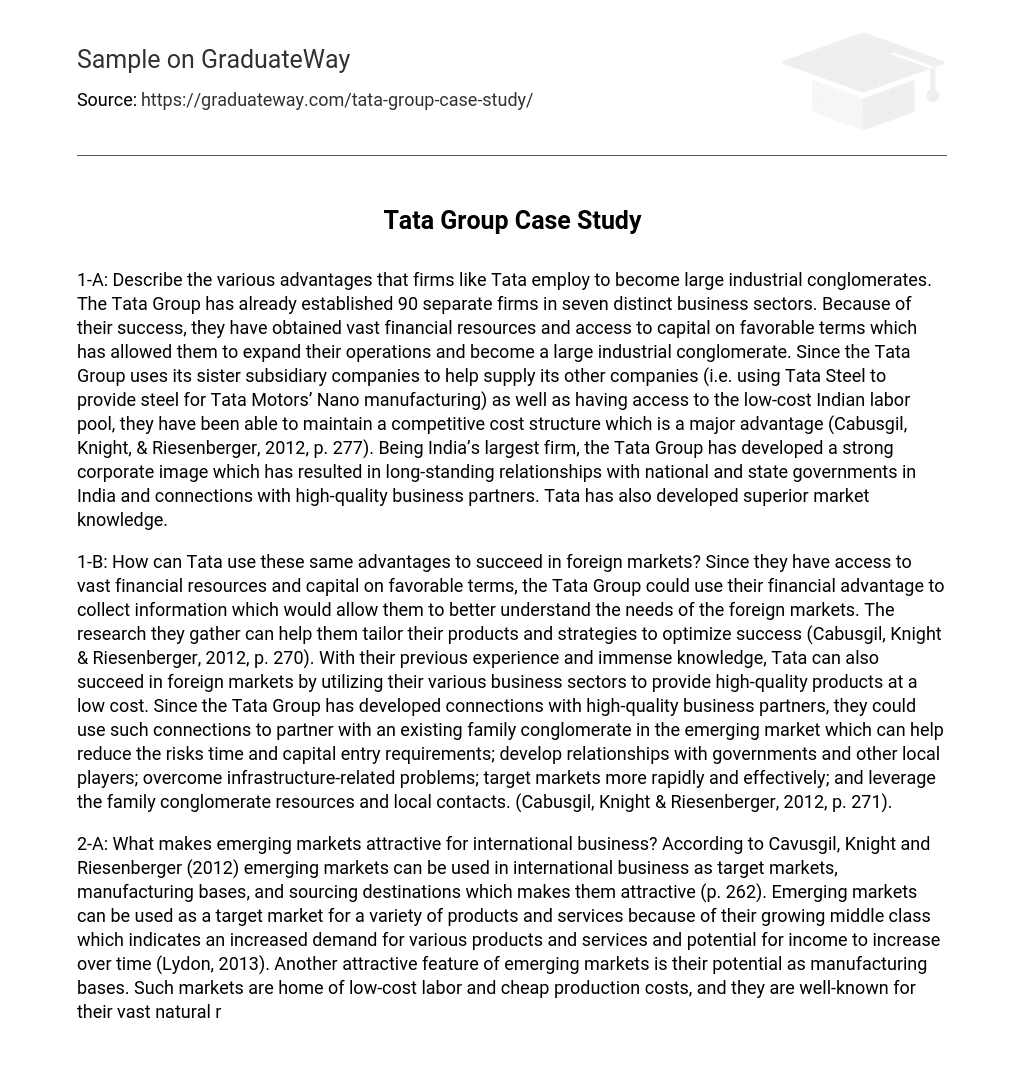Describe the various advantages that firms like Tata employ to become large industrial conglomerates
The Tata Group has already established 90 separate firms in seven distinct business sectors. Because of their success, they have obtained vast financial resources and access to capital on favorable terms which has allowed them to expand their operations and become a large industrial conglomerate.
Since the Tata Group uses its sister subsidiary companies to help supply its other companies (i.e. using Tata Steel to provide steel for Tata Motors’ Nano manufacturing) as well as having access to the low-cost Indian labor pool, they have been able to maintain a competitive cost structure which is a major advantage (Cabusgil, Knight, & Riesenberger, 2012, p. 277).
Being India’s largest firm, the Tata Group has developed a strong corporate image which has resulted in long-standing relationships with national and state governments in India and connections with high-quality business partners. Tata has also developed superior market knowledge.
How can Tata use these same advantages to succeed in foreign markets?
Since they have access to vast financial resources and capital on favorable terms, the Tata Group could use their financial advantage to collect information which would allow them to better understand the needs of the foreign markets. The research they gather can help them tailor their products and strategies to optimize success (Cabusgil, Knight & Riesenberger, 2012, p. 270).
With their previous experience and immense knowledge, Tata can also succeed in foreign markets by utilizing their various business sectors to provide high-quality products at a low cost. Since the Tata Group has developed connections with high-quality business partners, they could use such connections to partner with an existing family conglomerate in the emerging market which can help reduce the risks time and capital entry requirements; develop relationships with governments and other local players; overcome infrastructure-related problems; target markets more rapidly and effectively; and leverage the family conglomerate resources and local contacts. (Cabusgil, Knight & Riesenberger, 2012, p. 271).
What makes emerging markets attractive for international business?
According to Cavusgil, Knight and Riesenberger (2012) emerging markets can be used in international business as target markets, manufacturing bases, and sourcing destinations which makes them attractive (p. 262). Emerging markets can be used as a target market for a variety of products and services because of their growing middle class which indicates an increased demand for various products and services and potential for income to increase over time (Lydon, 2013).
Another attractive feature of emerging markets is their potential as manufacturing bases. Such markets are home of low-cost labor and cheap production costs, and they are well-known for their vast natural resources manufacturing and assembly operations (“Six global trends,” n.d.).
Emerging markets can also be used to help firms obtain a competitive through outsourcing which refers to obtaining value-adding activities from independent suppliers or company-owned subsidiaries. Firms can rely on foreign suppliers or production bases (known as global outsourcing or offshoring) to procure these value-adding activities (Cabusgil, Knight, & Riesenberger, 2012, p. 264). Offshoring is attractive to firms because they can obtain value-adding activities at a lesser cost then it would be for them to perform such activities themselves.
Given growth rates and other characteristics of emerging markets, what markets should Tamo target for sales of the Nano cars?
Tamo should target markets with a large sector of low-income consumers for the sale of the Nano. The launch of the Nano has allowed for consumers to purchase a vehicle who would not normally have the funds to do so. Tamo should target the emerging markets in countries such as Thailand, Vietnam and Indonesia (Cabusgil, Knight, & Riesenberger, 2012, p. 277).
Countries like those previously mentioned have an approximate per-capita income that is less than that of advanced economies but is greater than developing economies. This income level allows for just enough disposable income for a family to purchase a car such as the Tata Nano because of its small price tag. Not only should Tamo target said countries because of their income levels, but they should also target them because of the large amount of motorcycle-driving consumers. Last year alone, seven million new motorcycles were sold in Indonesia (Brainbridge, 2013).
According to Brainbridge (2013) this “bike boom” is due to consumers needing an alternative transport system aside from public transportation. The average price for a motorcycle in Indonesia is about 50 million rupees, and the average price of the Nano is about 130 million rupees. By offering a car that fit twice as many bodies for a slightly larger price tag Tamo can give consumers in emerging markets another alternative to the public transportation system besides motorcycles that is more family-oriented (Siddharth, 2011).
References
- Brainbridge, A. (2013, April 15). Indonesia’s bikers drive booming sector – ABC News (Australian Broadcasting Corporation). ABC.net.au. Retrieved October 20, 2013, from http://www.abc.net.au/news/2013-04-12/indonesian-bikers-drive-booming-sector/4626444
- Cavusgil, S. T., Knight, G. A., & Riesenberger, J. R. (2012). International business: the new realities (2nd ed.). Upper Saddle River,





